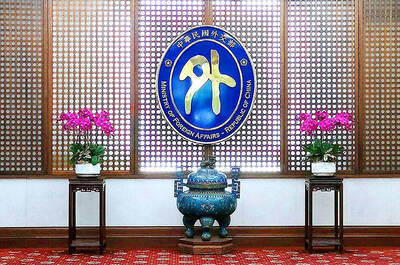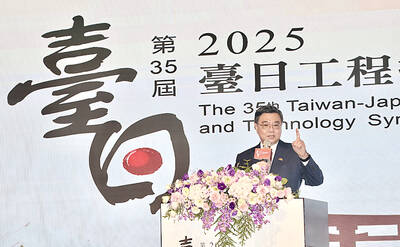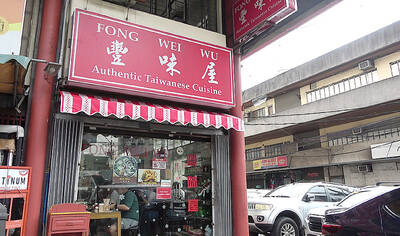The US military has developed a comprehensive operational plan to fight China and defend Taiwan in case of a Chinese attack, according to a recent news article and comments by Taipei Times sources.
The plan, which is overseen by the US Pacific Command headquartered in Honolulu, involves not only US Pacific forces, but also US troops and equipment worldwide, according to military experts.
And, while the plan, officially designated "Oplan 5077-04," includes provisions for the possible use of nuclear weapons, the focus of that section of the plan is that nuclear weapons should be avoided.
The Pentagon refused to comment on Oplan 5077, whose details remain top secret.
"It is [Department of Defense] policy to not comment on the specifics of operational plans," Pentagon spokesman Brian Maka told the Taipei Times.
While the existence of Oplan 5077 has long been known among military specialists in Washington, details were first made public in a recent article by military affairs journalist and former intelligence agent William Arkin in an article posted on the Washington Post Web site. Other details were supplied to the Taipei Times by military specialists in Washington.
While Oplan 5077 has been around since the Reagan presidency, it was elevated from a conceptual plan to an operational plan with assigned forces and detailed annexes in 2001, shortly after the [George W.] Bush administration took office, according to Arkin.
"The Pacific command developed a new `strategic concept' for the Taiwan contingency in December 2002, and an updated plan was produced in July 2003. Last year, based upon new 2004 guidance from Secretary of Defense Donald Rumsfeld and the Joint Chiefs of Staff ... a final Taiwan defense plan was published," Arkin wrote.
The plan now includes "air, naval, ground amphibious, and missile defense forces and `excursions' to defend Taiwan. Options include maritime intercept operations in the Taiwan straits [sic], attacks on Chinese targets on the mainland, information warfare and `non-kinetic' options, even the potential use of American nuclear weapons," Arkin wrote.
While the elevation of the plan to an operational component of the Pacific Command's mandate coincided with the installation of the Bush administration, many credit its current status as a final strategy for dealing with a Chinese attack with former commander in chief of the US Pacific Command, Admiral Dennis Blair.
"It was Admiral Blair who said, `Let's get serious about the defense of Taiwan,'" said retired Admiral Eric McVadon, a leading military consultant in Washington.
Blair had two aims when he took over, McVadon says. One was to develop good military relations with China. The other was to boost Taiwan's defense.
Despite his several trips to China to improve relations, Blair "hedged" his relations with Chinese, feeling that "it is prudent for us to realize that things might go badly, and we need to let them know the consequences of it," McVadon said.
There is no reason to believe that Blair's successor as Pacific commander, Admiral William Fallon, is not continuing with Blair's philosophy, McVadon says.
Blair was credited with opening up greater military to military channels between the US and Taiwan, greatly expanding communications between the two countries' armed forces.
This came despite hesitation in Washington about such steps among people who felt the cooperation would anger China. The US Senate has repeatedly rejected legislation passed by the House to enhance US-Taiwan military-to-military ties.
And, while China complained about Blair's activities, the protests were relatively muted.
Significantly, in recent years, Blair has become the regular senior US observer to Taiwan's annual Han Kuang military exercises.
"Blair knows what went on with 5077, so when he observes the exercises, he is able to evaluate it in light of his knowledge about what the coordination is likely to be and what the goals are," one source noted.
"So, even if he does not mention it, when he says something, astute people in Taiwan know that he's speaking from a position of authority with respect to knowledge about the Oplan," the source said.
Taiwan's supporters in Washington welcomed the disclosure of Oplan 5077.
"It is at least a relief to discover that the US government has taken very seriously the requirement to be able to react to an attack on Taiwan and that it has recently been updated to factor in, I assume, China's constantly expanding level of capability," said Richard Fisher, an expert on China's military and vice president of the International Assessment and Strategy Center.
Fisher sees the plan as stemming from the Taiwan Relations Act's mandate that the US maintain the capability to help Taiwan defend itself in case of a Chinese military attack. Fisher noted that the former conceptual plan was turned into the Oplan only after Bush was elected in 2000.
"George Bush's [April] 2001 statements [that the US would do `whatever it takes' to defend Taiwan] would have constituted an indirect order to the Pacific Command to prepare, or at least to update, existing plans and preparations for a possible conflict over Taiwan," Fisher says.
Arkin, however told the Taipei Times that work on the plan was deflected by the Sept. 11 terrorist attacks and Bush's concentration on Iraq, and that the work on the plan in late 2002 and 2003 actually reflected a return to a focus on dealing with Chinese military action.
A potential war with China had been a major focus in the eight years before Sept. 11, Arkin says. He also sees 5077 as a response to a military-wide contingency planning guidance issued by Rumsfeld earlier.
Arkin says that the administration has put a greater emphasis recently on missile defense, maritime intercept and to some degree on air defense issues, all of which could be main components of any battle in the Taiwan Strait.
He also notes that in the case of Taiwan, US global military capabilities would be brought into play. These would include a better computer network, a finer-tuned capability to go after China's air defense network, a "well-oiled maritime intercept capability and an improved naval missile defense capability which would allow the United States to interpose itself between Taiwan and China."

The Ministry of Foreign Affairs (MOFA) yesterday voiced dissatisfaction with the Comprehensive and Progressive Agreement for Trans- Pacific Partnership (CPTPP), whose latest meeting, concluded earlier the same day, appeared not to address the country’s application. In a statement, MOFA said the CPTPP commission had "once again failed to fairly process Taiwan’s application," attributing the inaction to the bloc’s "succumbing to political pressure," without elaborating. Taiwan submitted its CPTPP application under the name "Separate Customs Territory of Taiwan, Penghu, Kinmen and Matsu" on Sept. 22, 2021 -- less than a week after China

ALIGNED THINKING: Taiwan and Japan have a mutual interest in trade, culture and engineering, and can work together for stability, Cho Jung-tai said Taiwan and Japan are two like-minded countries willing to work together to form a “safety barrier” in the Indo-Pacific region, Premier Cho Jung-tai (卓榮泰) yesterday said at the opening ceremony of the 35th Taiwan-Japan Modern Engineering and Technology Symposium in Taipei. Taiwan and Japan are close geographically and closer emotionally, he added. Citing the overflowing of a barrier lake in the Mataian River (馬太鞍溪) in September, Cho said the submersible water level sensors given by Japan during the disaster helped Taiwan monitor the lake’s water levels more accurately. Japan also provided a lot of vaccines early in the outbreak of the COVID-19 pandemic,

Kaohsiung Mayor Chen Chi-mai (陳其邁) on Monday announced light shows and themed traffic lights to welcome fans of South Korean pop group Twice to the port city. The group is to play Kaohsiung on Saturday as part of its “This Is For” world tour. It would be the group’s first performance in Taiwan since its debut 10 years ago. The all-female group consists of five South Koreans, three Japanese and Tainan’s Chou Tzu-yu (周子瑜), the first Taiwan-born and raised member of a South Korean girl group. To promote the group’s arrival, the city has been holding a series of events, including a pop-up

A home-style restaurant opened by a Taiwanese woman in Quezon City in Metro Manila has been featured in the first-ever Michelin Guide honoring exceptional restaurants in the Philippines. The restaurant, Fong Wei Wu (豐味屋), was one of 74 eateries to receive a “Michelin Selected” honor in the guide, while one restaurant received two Michelin stars, eight received one star and 25 were awarded a “Bib Gourmand.” The guide, which was limited to restaurants in Metro Manila and Cebu, was published on Oct. 30. In an interview, Feng Wei Wu’s owner and chef, Linda, said that as a restaurateur in her 60s, receiving an